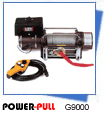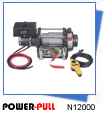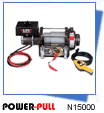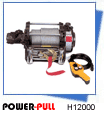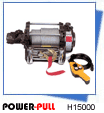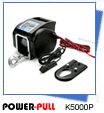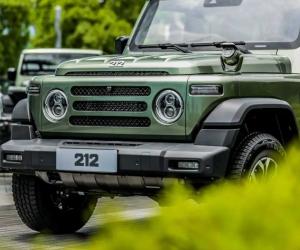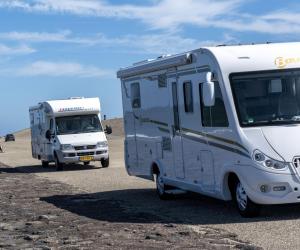绞盘测评:WARN_3.0ci_Winch
Today's Open-class 4x4 ATVs are technological marvels. With powerful engines, rugged transmissions and rock-defying ground clearances, they are engineered to claw and climb their way over, around and through just about anything imaginable. With all the advantages that come with the bigger and more powerful 4x4s, there is one undeniable downside: increased weight. The lightest of the Open-class 4x4s weighs in at 600 lb., and the behemoths are closer to 750 lb. dry. Although it's a challenge to get one of these monsters stuck or hung up on something, when you do you'll be glad you have a winch--if you don't, you'll be cursing yourself. We've never seen anyone regret having a winch.
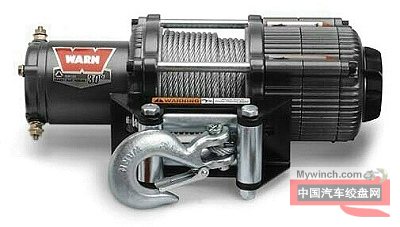
Over past ten or fifyeen.As ATVs have gotten bigger and their load and towing capacities have increased, so has the need for more powerful winches to pull them out on the rare occasions they do get stuck. Out in front with the equipment to meet that need is Warn, with the introduction of its newest, highest-capacity ATV winch: the 3.0ci.
The Winch
The 3.0ci winch has a 0.9-hp motor and a gear train that gives it a 3000-lb. pulling capacity. Like all winch ratings, the 3,000-lb maximum winching power is attained when the cable is extended all the way out and it's on the first turn of the spool. Pulling power decreases with each layer of cable on the spool. The 3.0ci is designed to be extremely durable in all conditions. It has eight sealed areas to protect against the elements, potted electrical components to fend off moisture and a rugged steel alloy gear housing to go the distance. The winch kit comes complete with a handheld remote control, handlebar-mounted mini-rocker switch, contactor, six-gauge wiring, roller fairlead, hook with safety latch, hook strap and a universal mount (even though it does come with a universal mount, it's desirable to pick up one of Warn's optional mounting systems designed specifically for your ATV). The fit will be much better and will make installation far easier.
Installation
To test Warn's newest offering, we mounted the 3.0ci--using the optional mounting system--on an Arctic Cat 500. The instructions for the mounting system and the winch are clearly written, easy to understand and not, as is often the case, so long and drawn-out as to make your eyes glaze over. The first step was to mount the winch and 4-way roller fairlead to the mounting plate. This was accomplished easily enough with four bolts and washers. The next step was to remove a plastic cover from the Arctic Cat (incidentally, Arctic Cat designed the front end frame specifically to mount a Warn winch). Then we were to simply bolt on the winch assembly in place of the plastic cover. This procedure is usually easier said than done, and this time was no exception. After spending a considerable amount of time trying to get the bolts all in and lined up as instructed, we gave up and looked for an alternative route. We unbolted the winch from the mounting plate and checked to make sure the mounting plate holes lined up with the bolt holes in the frame. Sure enough, they lined up exactly; we realized the problem was with the tight clearances between the winch and the frame. So we put the winch in the frame, bolted the mount up and then bolted the winch to the mount. The winch itself incorporates floating nuts, which allowed us enough adjustment to get it all to fit. It was a tight fit, but nothing was hindered and the installation looked great. After the winch was securely mounted, it was time to hook up all the electrical components. Electrical connections are typically the most difficult part of projects, what with figuring out how to route the wires, finding the proper power connection and locating a good place to mount the contactor. Fortunately, the layout of the Arctic Cat, the smooth design of the winch's electrical components and the excellent instructions made for a relatively painless installation. The biggest problem we had was finding a place to tuck the extra length of wire. Since the winch is designed to be mounted on virtually any utility ATV, it comes with wires long enough to accommodate any of them. While we would rather have the wire too long than too short, all that leftover wiring does present the challenge of safely tucking it away or the need to cut and re-terminate the wires. Again, the ample room on the Arctic Cat reduced the "problem" to little more than an inconvenience.
Overall the installation lasted about four hours, which was probably a bit longer than it should normally take, as we made certain that everything was thoroughly checked over. The finished product had the appearance of a factory installation and would say that, despite a couple of minor issues along the way, the fit and finish are first-rate.
Performance
With a new winch installed there is only one thing to do: get the quad buried and stuck in the most imaginative way possible. That is exactly what we set out to do, which is when we ran into our first problem: we couldn't get the big Arctic Cat stuck! We tried and tried, but no luck--it just wouldn't happen. So we wound up pulling the big Cat up some hills and over some logs with the winch just to see if it worked. It did--flawlessly, we might add--and even pulled the ATV up a hill in gear, by accident of course. The handheld remote worked perfectly and will provide you a great level of safety, and comfort, if you have to get your stuck ATV up a hill or out of a waterhole.
As for the quad, well, while pullling it up and over obstacles may be fun for a little while, we quickly tired of it and, for the sake of the review, decided to try one more time to get it stuck. We stumbled on what appeared to be an impassible water hole; throwing all caution to the wind, we plunged in. The Cat burbled and clawed but couldn't get out of the three-foot-deep, steep-banked hole. The rider gave it all he could but only managed to dig the machine in deeper. Now the winch wasn't a luxury but a necessity, because if it didn't work we had no idea how we were going to get the nearly 650-lb. ATV out of there! So we unspooled the cable, attached it to the nearest tree, crossed our fingers and hit the button. Without hesitation the winch began to wind up its cable and easily pulled the deeply mired ATV free and clear. We were all duly impressed--and thankful.
A 3000-lb.-capacity winch may seem like a little bit of overkill for a 650-lb. ATV. However, with its racks loaded to maximum capacity, a combined front/rear payload of 300 lb. and a 1,000-lb. trailer in tow, the Arctic Cat 500 didn't come up too shy of the winch's max capacity, especially when you factor in the extra force required to break it loose from whatever it is stuck in. With many ATVs falling into the same weight category as the Cat--and some even bigger--not only does Warn fill a need in the industry with the 3.0ci, but accomplishes it with a solidly designed product that looks good and performs better. We definitely recommend this winch for large ATVs; in fact, if you ever have the bad luck to get your behemoth hopelessly stuck somewhere, we--and you--might even call it a necessity. It's especially handy for people who routinely ride alone.



